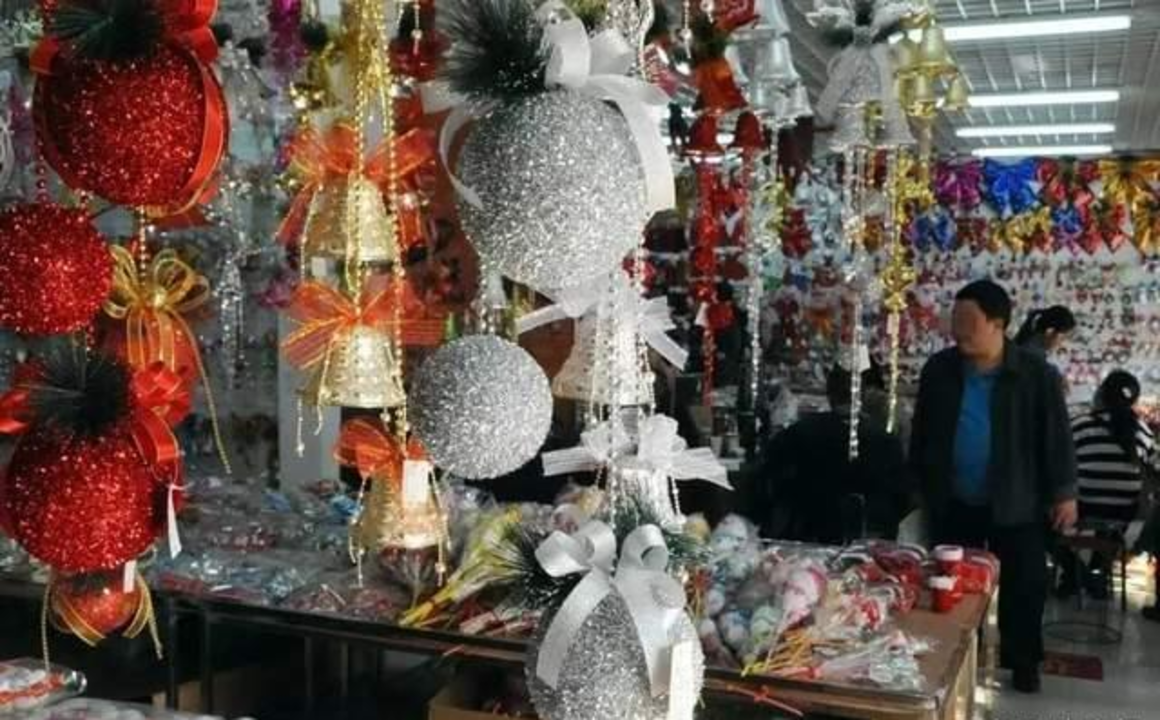Chapter 1: “Christmas Village” in the world
It’s been a cold winter this year, with snow flurries in the windows of Macy’s in the USA and fantastic decorations in red and green, decorating the most lively Christmas atmosphere.
On the back of 500 stalls, there are more than 600 Christmas factories and family workshops hidden in the surrounding towns and villages of Yiwu.
The most famous place in Yiwu is the Yiwu International Trade City, which is divided into five districts and the District 1 is known as China’s “Christmas Village”.
Dense stalls, both inside and out, with all the Christmas items you can think of are in the commercial and residential buildings in Yiwu, such as Christmas trees, baubles, simulated snow, Santa hats, moose, and LED lights. Another thing to mention is that Christmas music is played here all year round.
Towards the end of the year, these kinds of stalls close much earlier each day than their counterparts who selling tourist goods on the account that the busiest time of the year has gone past.
Most North American customers come to Yiwu Market in the summer due to sea transportation, and the foreign trade business in Christmas Village is basically over by end of September. After that time, most of those who come are Korean and Japanese.
For foreign businessmen, Christmas Village is a shrine of gold-washing.
The Canadian guy, Jack will come to Yiwu for a pilgrimage in the hottest time of the year. And he earned his first bucket of gold by selling Christmas hats for the first year here.
Europeans are more fortunate than North Americans because of the contribution from the “Belt and Road” strategy and the opening of the “YiXinOu” railroad. the shipping cost of one container was reduced from the original 40 days with 1500 U.S. dollars to 15 days 500 U.S. dollars by rail transport.
At the same time, the Chinese businessmen in the Christmas village have gradually figured out the consumption characteristics of people from different countries.
“Europeans not have a taste for unadorned but pay attention to environmental protection; Australians are more pristine and usually go outside to cut a tree at random; For sale in South America, you need a green tree with red streamers red, preferably with some purple lights “
Of course, these foreign businessmen have one character in common: they focus on the cost performance of Yiwu.
Yiwu businessman doing Christmas business for more than a decade, said, “the sample needs to see a minute and the price needs to talk about a week in the process of business with foreigners, sometimes they will go to Southeast Asia to find similar sources, but there is no doubt that the price from Yiwu is certainly the most competitive in the world.”
Chapter 2: Over 600 Christmas Factories in Yiwu
There were only a few Christmas merchandise stores in Yiwu before the millennium, by contrast, there are more than 500 Christmas merchants here now.
On the back of 500 stalls, there are more than 600 Christmas factories and family workshops hidden in the surrounding towns and villages of Yiwu.
This is a business based on the season. The workers’ monthly salary is only 2,000 to 3,000 yuan in the slack season, however, sometimes there is no one we can recruit with a salary of more than 6,000 yuan in the peak season.
When a big order for tens of thousands of Christmas trees comes in, the workers will work 12-hour shifts every day to deliver the trees within one month. If the big factory can’t finish it on time, it will be allocated to the small factories. By the way, if the small factory couldn’t finish it, it would be distributed to private individuals.
Old Wei 38 years old, young Wei 19 years old, The father is 38 and the son is 19 who are in a common family and come from Guizhou and whose duties include putting a plastic snowflake in the glue soaked for 3 seconds, and then sprayed with red powder. In order to avoid inhaling too much dust, they have to change 10 pairs of masks every day.
They can do such gadgets 5000 a day to earn 3000 yuan a month. The father hopes to earn enough money to marry his daughter-in-law early, and then go home together.
Every summer, workers from Anhui, Henan, Jiangxi, Guizhou, local rural women in Yiwu, and unemployed youth gathered into an army of Christmas, who produce more than 80% Christmas items in the assembly line for the global people.
Cai Qinliang, secretary-general of the Yiwu Christmas productions industry association, said: ”Any country or region where Christmas is celebrated is their customer.”
The Washington Post has publicly stated that the global Christmas can not be separated from Yiwu. In January this year, a Swedish director even came to Yiwu to filmed a Christmas-themed documentary.
Interestingly, U.S. importers have tried to obstruct Yiwu’s business in the impact of the trade war.
In 2018, several containers of Christmas supplies have entered the port, the product infringement was suddenly questioned by other sides, making huge claims.
However, after two weeks of stalling, the goods eventually entered the U.S. market without incident.
Cai Qinliang said, “What Trump does is none of our business, we don’t do Christmas, we only produce Christmas productions, the US relies on Chinese manufacturers, and eventually the U.S. tariffs will be passed on to the American consumers.”
Chapter 3: Fit-Trees in the USA
Beth is the owner of a farm in Pennsylvania in the USA, where she planted tens of thousands of Douglas fir-trees.
In the United States, there are 15,000 similar farms, which grow more than 10 different kinds of Christmas trees, a total of 350 million trees.
But every year, only 25 million of them will go to the market, accounting for only 20% of the total Christmas tree market.
The reason for this is simple: it’s different than a Christmas tree’s growth cycle is quite long compared with other crops, on average, it takes 8 to 10 years to grow to the extent that it can be sold, only 2 meters in height.
The long growth cycle has become a financial issue for the farmer.
In the 1990s, U.S. farmers planted too many Christmas trees to exceed the demand. And caused their prices to hit rock bottom throughout the early 2000s, resulting in many farms went out of business.
But during the economic crisis of 2008, so few Christmas trees were planted caused a situation that the price of real Christmas trees in the US has skyrocketed since 2016.
According to the American Christmas Tree Association, the average selling price of a real Christmas tree in 2019 is $75 per tree, while an artificial Christmas tree is $107.
Although the artificial trees sell for more, buying a real tree every year is not cost-effective by comparison, considering that high-quality artificial trees can be recycled for 10 years.
The growth cycle of a real tree takes 8 to 10 years, but in the factory in Yiwu, China, the assembly line workers on full power only need 2 minutes to make 1500 artificial trees.
Meanwhile, there are two main ways to sell real Christmas trees in the U.S. Either by customers to cut their trees at home, which usually sells for more, or by wholesale to supermarkets, which usually sells for less than $35, with more of the profit being made by retailers.
Overall, it is calculated that by growing Christmas trees, American farmers typically make a gross profit of only 25-30%, or $8 to $10 a tree. Further averaged out over each year, the profit can be quite meager.
Some American farmers believe that the “Made in China” is stealing their business, and it is impossible to disprove that the “Made in China” ( Import From China )is indeed competitive in the face of the general trend of globalization.
It should be noted, however, that the basis of this competitiveness springs from the country’s huge cheap labor force. And the intensity of workers working 12 hours in two-shift work matches with low pay.
Chapter 4: Merry Christmas, Yiwu
—-Documentary by Kladen kovačević
On December 14, the first snow of 2020 is coming into Yiwu and we arrived at the “Factory of the World” in the duration of this winner.
A huge Christmas tree stood in the snow drifting in the wind outside the Jin Fuyuan Christmas Market, giving it a very Christmas atmosphere. Although every shop was decorated with red and green Christmas decorations, there were hardly any customers of the whole floor in the crisis of the epidemic, while you are entering the market.
We asked the shop owners if they remembered that one foreigner had come here to make a documentary two years ago, and someone who immediately recalled, “Yes, they went to almost every shop at that time and asked around if they were willing to join it, and also came to my factory “.
The story of “Merry Christmas, Yiwu” begins with two girls coloring Christmas balls while talking about whether to go back home for the holidays. the documentary described the daily lives of five groups of families in an hour and a half.
A middle-aged couple who used to be farmers now works in a factory making Christmas item to pay for their son’s university education in the future.
A young couple starts a handicraft workshop for Christmas hats. They have to outsource the work to nearby villagers in the short of labor.
An older family of three opened a Christmas items factory. Although a great success was made in the business, they still lived in the staff quarters. The father is working hard to make the factory more stable and hopes to provide his daughter with the life she wants in the future.
A slightly younger family of four whose couple are from Wenling and now settle down in Yiwu. The new factory where can produce Christmas balls is about to be built, and the mother has decided not to run the business anymore and want to be a chaperone for her two sons who are going to primary school.
A twin, the older sister is away at school and the younger sister stays at home in Yiwu to learn the business. The older sister returns to Yiwu only during the school holiday and after that, the twin will work in the Christmas goods factory together.
In addition, the film also photographs a group of young people working in a factory, worrying about their relationships while feeling confused about their future
These people have different intimate relations with each other, like parents, husbands and wives, sisters, friends, colleagues, and show several issues of housing, children’s education, relationships and marriage, inter-generational conflicts, etc, which attract more attention of Chinese.
Director Mladen from Belgrade, the capital of Serbia, run around the US, Serbia, the UK, South Africa, and Australia in his whole school life and he used to be an action film director before moving on to documentary films.
Since making two documentaries focusing on his native land, he set his sights on the distant land. Mladen has an innate affinity with China on account of his birth in a former socialist country. “Things that Westerners find strange are familiar to me, and I also wore a red scarf in my childhood.”
He had a professional production team in China, which took the responsibility of most communication with the subjects. During the shoot, besides him and the cameraman, the rest of the team were also Chinese.
Yang Yi, the producer, who was with the team throughout the shooting, told us that apart from the preliminary research, they also conducted 4-5 days’ research before every official shoot, which was summarized into a thick document and sent to Mladen. He even followed his interviewees back home to Anhui Province for the sake of researching more deeply.
“There are a total of 35 characters appearing in the film, but the number of actual filming was at least twice of that.” Director Mladen told us.
We obtained the contact details of part of the interviewees at the time with help of Yangyi, calling them back one by one. Some of them had changed their phone, some had left Yiwu after the factories had been demolished, and most had remained in the markets of the time, whose lives had no misfortune.
Mladen was astonished at the ‘speed of China‘ in his sight. “The process of making this documentary was actually a course of exploring and understanding contemporary China for me.”
The following is Mladen‘s own account:
I’ve always wanted to make a documentary about China, which can not show the real life of Chinese people, but resonate with Westerners at the same time, Christmas was a perfect entry point. News by My Sourcify







